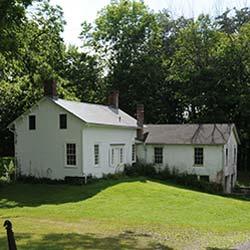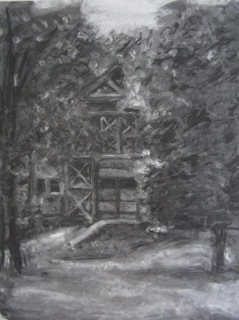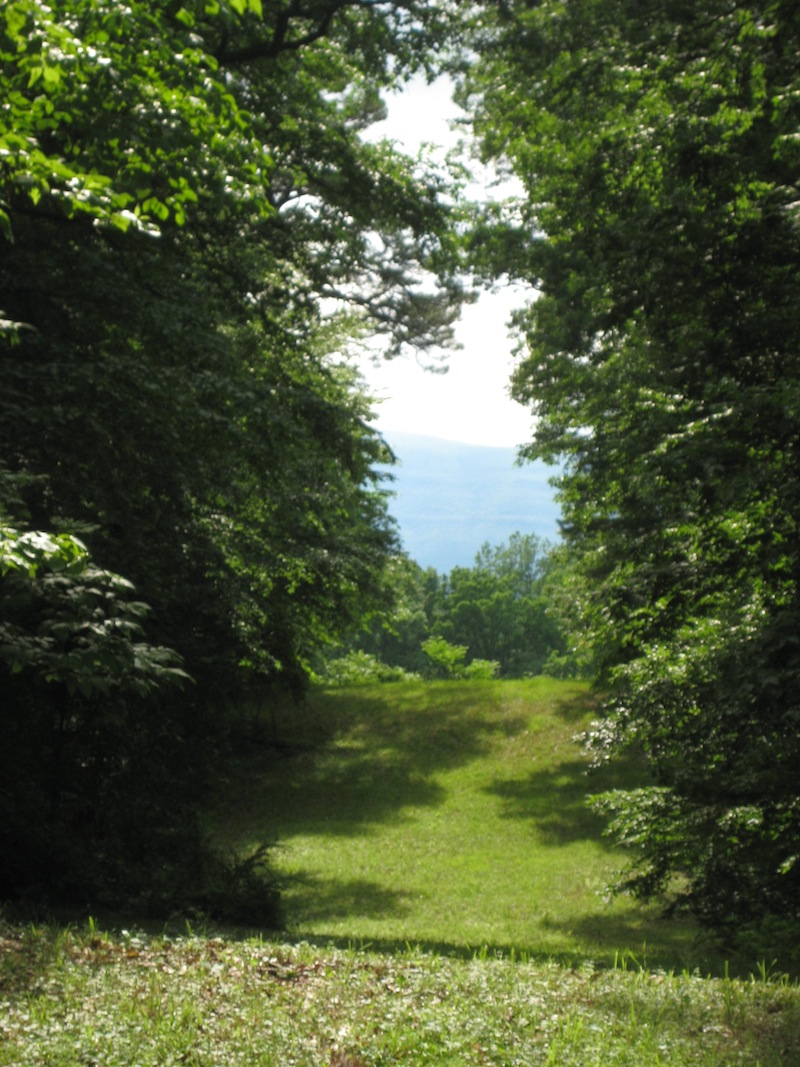One of the many great things about living on my road is that one of my “neighbors” is Clermont Historic Site. About 3 miles south, it is an approximately 500 acre State Park, formerly home to seven generations of the Livingston Family. Being so close, it is very easy for me pop down on my car or bike, take a quick twenty minute stroll or wander around for an hour or two. With its combination of views, nature and architecture, it has also allowed me to channel my inner Thomas Kinkade, and I have begun drawing some of its elements. This walk will take you on an easy loop around the mansion and the gardens, as well as some of the other buildings on the estate, showing not only some of the sites, but also some of the drawings I have done of them.
One enters the Park through a modern but attractive winding drive, ending at a very large parking lot overlooking the grassy knolls undulating down towards the Hudson. there is a visitors center located in the former carriage barn, where one can learn information about the property can purchase tickets for house tours. The house and the multi-generational stories of its denizens are fascinating and well worth touring, and deserving of their own blog post at a later date. To the left of the visitors center, an asphalt path through a lilac walk leads one to the mansion.
The white building consists of a Georgian core and nineteenth century additions, lending it a grand but not overpowering air. One approaches the house from the back, and walk around the large building reveals a visual reward. Perched on a bank over looking the Hudson, the stone paved forecourt presided over by a pair of lions affords sublime views of the Catskill Mountains in the distance.
 Returning to the backside of the house one enters the gardens, which have always held an allure for me. The ones we see today bear the mark of Alice Clarkson Livingston, a great gardener. The formal terraces, presided over by a classical statue, and the adjacent low walled garden, not only reflect the formality of the Italian Gardens she would have known while living, there, but are also deftly blended into the natural environment of their rural New York location. A walk through a woodland garden with its pool
Returning to the backside of the house one enters the gardens, which have always held an allure for me. The ones we see today bear the mark of Alice Clarkson Livingston, a great gardener. The formal terraces, presided over by a classical statue, and the adjacent low walled garden, not only reflect the formality of the Italian Gardens she would have known while living, there, but are also deftly blended into the natural environment of their rural New York location. A walk through a woodland garden with its pool
 Photo from Friends of Clermont website
Photo from Friends of Clermont website
The building, currently being restored by The Friends of Clermont, became the residence of the last chatelaine of the Clermont estate, Alice Clarkson Livingston. She first moved to the cottage in the twentieth century for the winters when rising fuel costs and labor shortages made the big house too onerous to inhabit during the winter. Whether with regret or forethought, and having no grandchildren, she realized the era of her family being able live in and maintain the mansion on the great estate was coming to end. As the twentieth century march on, Alice remained in the gardeners cottage, building additions, including an apartment over the garage for her unmarried daughter Janet. Two years before her death in 1964, Alice donated the house and much of its contents to the State, who in turn bought about 400 surrounding acres to form a State Park.
Continuing up the dirt road, you will soon see the cow barn up on your left. Well preserved (at least appearing so from the exterior), the handsome structure is currently used by the state for storage I believe. The road gently veers upward through the fields and into the woods.
Well preserved (at least appearing so from the exterior), the handsome structure is currently used by the state for storage I believe. The road gently veers upward through the fields and into the woods. The road is lightly used, and one can often observe many of the birds and animals that can be found on the estate from here. Songbirds, woodpeckers, hawks, turkeys, rabbits, squirrels
The road is lightly used, and one can often observe many of the birds and animals that can be found on the estate from here. Songbirds, woodpeckers, hawks, turkeys, rabbits, squirrels , chimpmunks and deer are all commonly seen, along with an occasional fox or nun in the distance (there is a convent next door to the park). The road winds a bit and soon you come across Clermont Cottage.
, chimpmunks and deer are all commonly seen, along with an occasional fox or nun in the distance (there is a convent next door to the park). The road winds a bit and soon you come across Clermont Cottage. A former tenant or servants cottage, it became a “honeymoon cottage” for newly married members of the family. The last inhabitants were Alice’s daughter Honoria and her husband Reginald McVitty. When Alice died, she left the cottage and surrounding acreage to Honoria, who maintained it as a residence until her own death in 2000, at which time she willed it to the State, to be reunited with the Park.
A former tenant or servants cottage, it became a “honeymoon cottage” for newly married members of the family. The last inhabitants were Alice’s daughter Honoria and her husband Reginald McVitty. When Alice died, she left the cottage and surrounding acreage to Honoria, who maintained it as a residence until her own death in 2000, at which time she willed it to the State, to be reunited with the Park.
The house is currently awaiting a plan for restoration and adaptive re-use. With it’s rambling additions and picturesque well, it is charming and modestly scaled. There one undoubtedly majestic element to the spot however. Through the forests a view was cut and maintained across the estate and maintained, allowing the inhabitants of the cottage a regal view of the distant catskill mountains from their bedroom balcony.

A great way to complete this loop is to cut through the set of gates to the left

After that its back to the car, and off to reality.
Please note, given the size of the estate there are many walks one can take through the grounds, including a southerly route allowing the visitor a very different, but equally enchanting experience.


